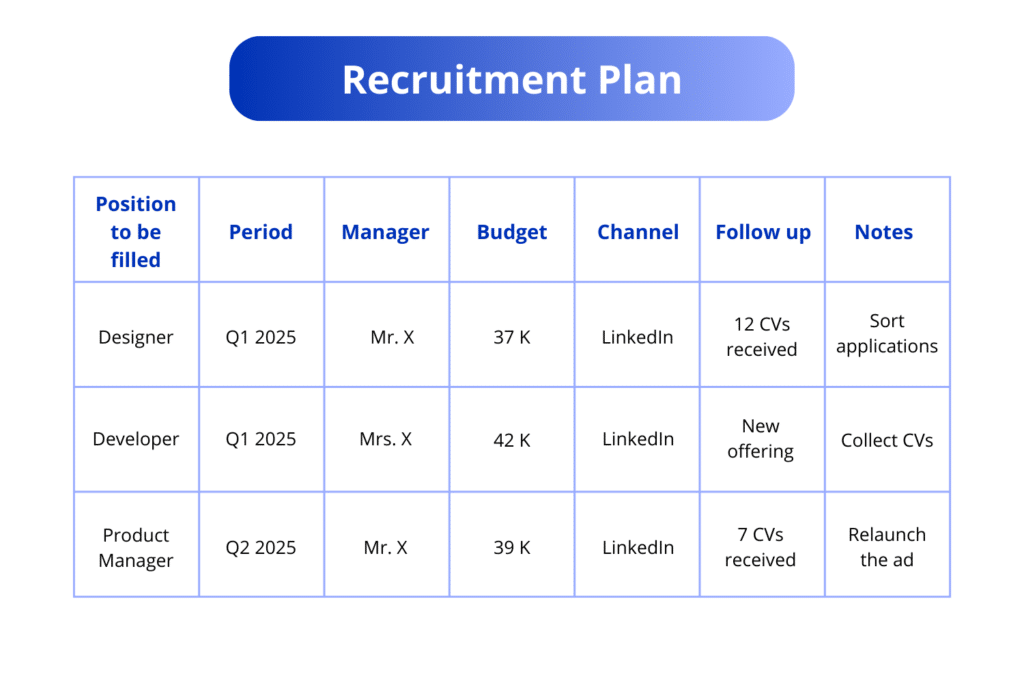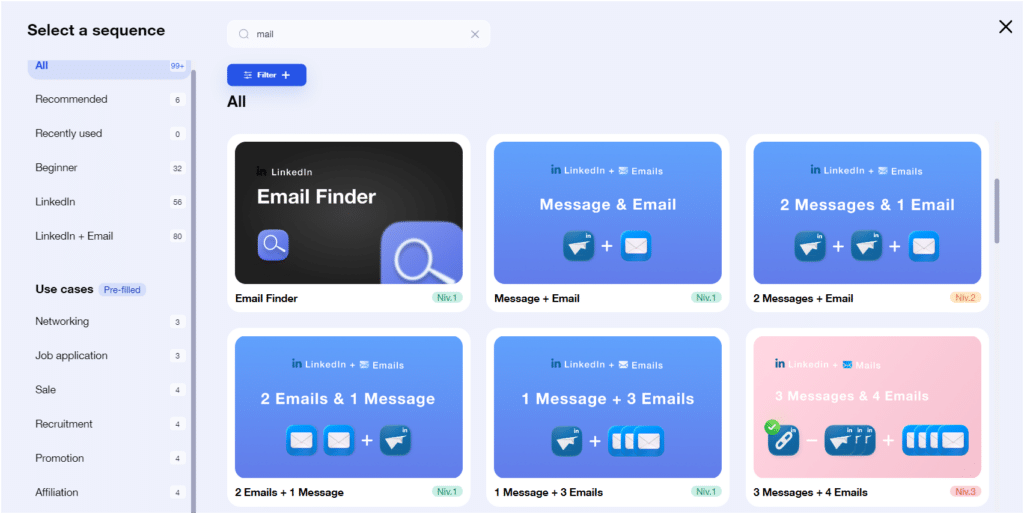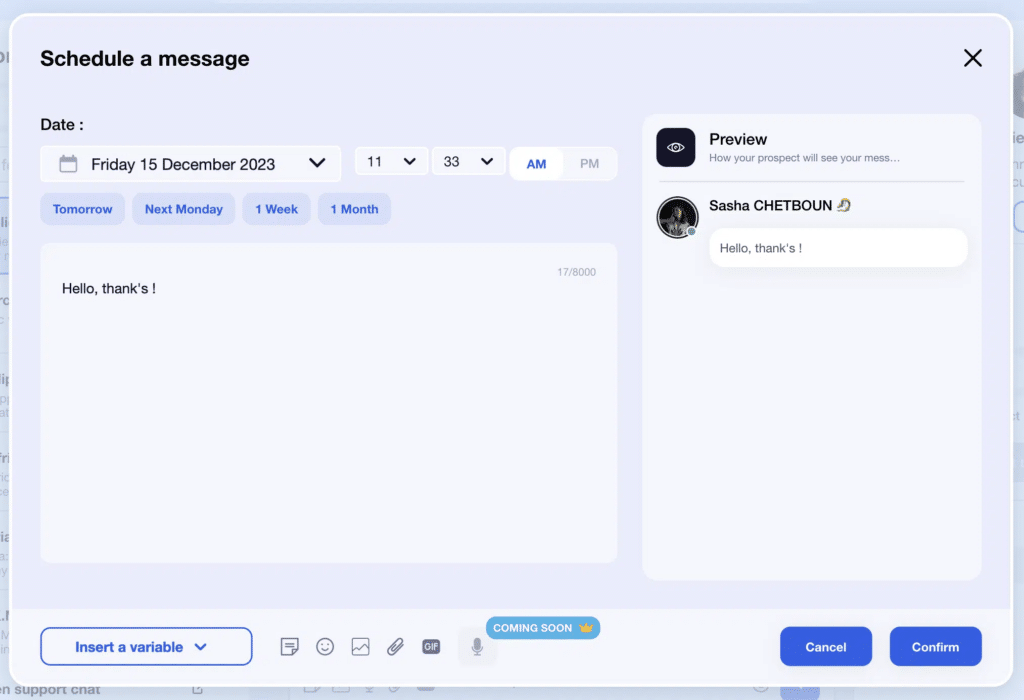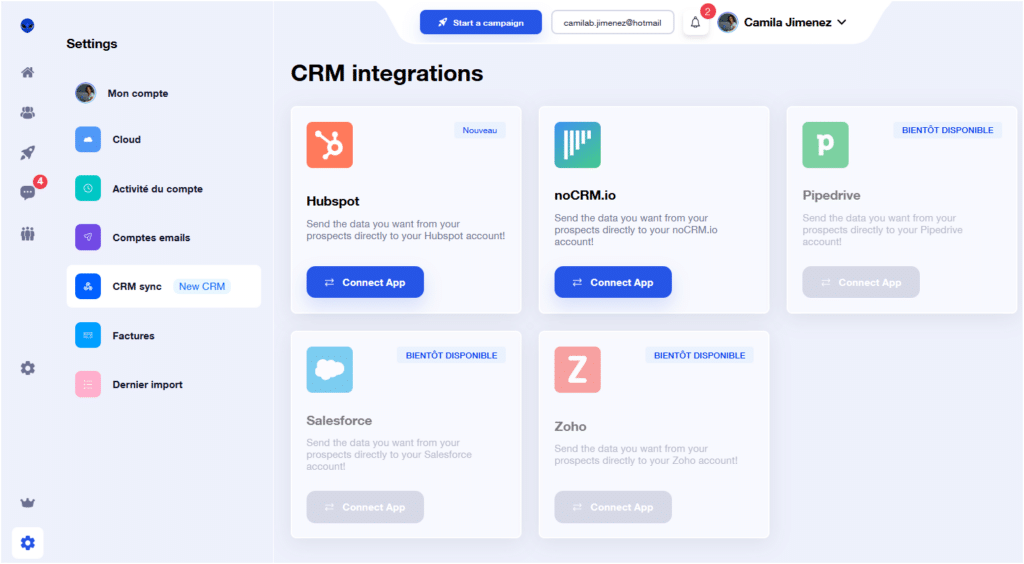A recruitment plan is a tool developed by HR departments or human resources specialists to attract, hire and retain talent within a company.
In this article, we tell you how to do it in 10 easy steps! ⚡
What is a recruitment plan? Definition
A recruitment plan, also known as a recruitment schedule, 👍 is a strategy put in place to effectively hire an employee within a company.
The recruitment plan enables clear goals to be achieved, and guides recruiters in their decisions and actions. It is also seen as a roadmap.
The recruitment plan provides precise answers to potential questions during the recruitment process. 🤔
For example, it allows you to answer the following questions:
- What are the criteria for choosing the perfect candidate?
- What is the full job description?
- What remuneration range could we suggest?
- Which recruitment method should be favored?
It is a reference document for recruiting managers, and needs to evolve in line with the job market and company requirements. ✔️ A relevant hiring plan must evolve over time.
So there’s no such thing as a one-size-fits-all recruitment plan – it has to be adapted to each company!
Sample recruitment plan
Rather than a long speech, here’s a sample recruitment plan to show you what it looks like and what essential elements to include: ⏬

Of course, you can adapt your table to suit your company’s needs! 🫡
How to draw up a 10-step recruitment plan?
The process of drawing up a recruitment plan can take some time… ⌚ It expresses the company’s hiring policy and the recruitment steps to be followed.
An effective hiring plan attracts the most qualified candidates!
Want to know how to recruit successfully? 👇 Here are 10 steps to follow:
1. Need identification
The recruitment plan inevitably begins with a representation of recruitment needs. 🧐 Needs are specific to the type of position targeted.
Here are some sample questions to help you determine your recruitment needs:
- What exactly is the job title?
- Is this a new position or a replacement?
- What type of employment contract is planned (fixed-term, permanent, temporary…)?
- Are we aiming for mass or targeted recruitment?
- What are the essential skills required for the job?
- When will I be integrated into the company?
- How much money is earmarked for recruitment?
- Etc.
Don’t hesitate to ask questions directly to the team or manager concerned, to get as much information as possible about the profile you’re looking for! 💡
2. Define who is responsible for the hiring process
For effective recruitment, it is necessary for the company to identify who will be in charge of the hiring process. 🙏 Depending on the profiles to be hired and the company’s skills, it is possible to outsource or insource the recruitment process.
Depending on the specific nature of the position to be filled, the assignment can be entrusted to the company’s HR department or to a specialized recruitment firm. 🕵️
3. Writing the job description
Once the recruitment needs have been identified, it’s time to write the job advert. 🎯 This must meet the key needs targeted by the company.
It must be attractive, clear and capable of attracting the most competent profiles!
Here’s our hack: You can use a “prompt” like this one, on Chat GPT to create the perfect job description. 😉
“Put yourself in the role of a recruiter [indicate sector].
Draw up a job description for the recruitment of a [job name].
In [type of contract CDD, CDI, Temporary, Internship, Apprenticeship, etc].
At [company name + description + location].
This person will join the company on [date].
In order to carry out [overall mission of the position].
Experience required: [X years].
Proposed salary range [gross or net amount].
Benefits: [teleworking, gift vouchers, luncheon vouchers, etc.].
The job ad should be structured in several sections: presentation of the company, main tasks, desired profile and requirements for the position, benefits and salary.
Make sure the job ad is well organized and relevant, according to current legislation.
The ad should adopt a [tone to be determined] tone.”
4. Distribution channels
The selection of channels for disseminating the offer is a crucial part of the hiring plan. ⚡The channel selected will have an impact on the type of recruitment.
It’s crucial to determine the channel or channels that best enable you to identify suitable candidate profiles. 🤩
Between social media, company career sites, job boards, cooptation… the choice is yours!
However, our preferred distribution channel will always remain LinkedIn. 👑
Here’s our tutorial on how to find candidates on LinkedIn and boost your recruitment methods.
5. Sourcing methods
In addition to determining the channels through which your offers will be distributed, it’s also necessary to choose the sourcing methods to locate your candidates. 🔍
Here are a few techniques to consider:
- Analyze databases (resume libraries, applicant pools),
- Search using search engines,
- Participate in networking events,
- Join professional groups,
- Find institutional entities and collaborators.
- Contact schools, universities and training establishments.
- Post on job boards (generalist, specialized, free, paid…)
To be efficient in your recruitment processes, favor automated methods, which will help you reach targeted profiles for the position to be filled. 🦾
Learn how to launch a successful recruitment campaign here! 💯
6. Pre-selection of candidates
Pre-screening incoming CVs and cover letters is a crucial aspect of the hiring process. 🧨
At this stage, all the information provided by candidates must be carefully scrutinized:
- Availability,
- Old references,
- Outlook for the future,
- Expected salary,
- Hard and soft skills…
Pre-selection of qualified candidates must be based on the essential selection criteria set out at the start of the hiring plan. 👆
It’s worth noting that there are a number of “CV screening” software programs that use AI to help you find qualified candidates, such as Workable and Teamtailor, based on the information provided in resumes.
Afterward, you’ll be able to contact the best candidates for an interview! 📞
7. Candidate interview
The recruitment interview is used to validate or contradict a hunch. 🥸 Sometimes you can be surprised by a candidate once you’ve exchanged more!
The interview grid is an effective tool for judging and checking the skills required for the position in question, without prejudice: ⏬
– Candidate information: surname, first name, contact details, job title, department in question, name of line manager, date of meeting and name of HR manager who conducted the interview.
– Educational background.
– Professional experience.
– Skills required: technical skills expected for the position, with corresponding grade, as well as management skills.
– Expected interpersonal skills: list here the behavioral skills required. For example, team spirit, self-confidence, independence, sense of service…
– Tools mastered.
– General assessment of the applicant: this section is entirely subjective. The recruiter can express his or her impressions concerning the individual’s compatibility with the vacant position. But also about his or her desire to join the company.
– Anticipated remuneration for the applicant.
– Availability: request to work remotely, etc.
– Summary: the aim here is to get a quick overview, in a few lines, of the candidate’s potential. What are the candidate’s strengths, areas for improvement, bottlenecks and final opinion?
To design an effective scorecard, it’s best to include the main headings above. After that, it’s up to you to personalize them! 🤗
8. Hiring the candidate
Once all the applications have been received, it’s time to choose the best option! 🏆
An efficient recruitment schedule must facilitate the rapid identification of the talent that meets your team’s needs.
The hiring proposal is a step that needs to be well-prepared. 👀 The aim is to get the candidate to accept your offer.
The job offer should therefore include not only the crucial information from the job offer, but also the points agreed during the interview.
This is often done by e-mail, a few days after the interview. 📩 Don’t leave your candidates in suspense!
9. Candidate integration period
Onboarding is the final stage of the recruitment plan. 👏 Effective integration into the company and teams guarantees the success of the hiring process.
Human resources departments need to oversee the integration of new recruits to optimize talent retention! 🧰
It’s easier to retain talent and move them into new positions, than to have to hire and train recruits.
10. Process optimization
In today’s job market, the departure of an employee can cause problems for the company. 🙈 It is therefore crucial to maintain employee loyalty and intensify their sense of belonging, to prevent departures…
The idea is to gather information and feedback to improve the quality of future hires. 🙌 In this way, it’s possible to run post-hire astonishment reports to spot areas for improvement.
Finally, think about looking at your statistics too. 🤓 Recruiting software makes it easy to quickly access information about your hiring procedures, and will make reporting a breeze!
How to plan a successful recruitment campaign?
To develop an effective hiring plan, it’s advisable to adopt certain best practices to optimize your chances of success. 💫 Here’s our advice:
Do’s: ✅
– Adopt the SMART model: Ensure that recruitment requirements are specific, quantifiable, possible, real and time-based. This framework helps clarify goals, make results more concrete and simplify process monitoring. A clearly established goal removes uncertainties and makes it easier to quickly understand what is expected and in what timeframe.
– Involve stakeholders: It’s essential to work in cooperation with managers and teams to accurately capture the technical and behavioral skills required for the position. This ensures that expectations match and that the desired profile is in line with the situation on the ground.
– Include must-have skills and « skills plus »: Precise identification of must-have skills and those perceived as additional benefits facilitates more efficient ranking of applications. This also makes it possible to prioritize evaluation criteria during the selection process, focusing on what is really essential for the position.
Don’ts: ❌
– Don’t overload the skills profile: An overly broad or complicated range of skills can not only deter competent candidates who may feel less qualified, but also hinder the hiring process. It’s crucial to stay succinct and list only vital skills, so as not to get carried away with an intimidating or unrealistic list of criteria.
How can you automate your recruitment?
Automating the hiring process can change the way you involve and evaluate applicants, improving its efficiency while reducing its duration. ⌛
Here’s how to use Waalaxy to automate your recruitment plan:
- Build targeted recruitment campaigns: At Waalaxy, you can build customized campaigns to find profiles that match the skills and experience required for your available positions. 💯 Choose your target audience on LinkedIn using sophisticated filters, and set up automated sequences to contact them.

- Personalized messages: Waalaxy offers the possibility of adapting invitations and messages according to profile information, which boosts response rates as you show genuine interest in the candidate’s career path. 👀

- Automatic follow-ups: Our tool enables you to set up automated follow-ups for applicants who don’t respond to your first contact thanks to tailored campaigns. 🔔 Also, you can program follow-up messages in the Waalaxy Inbox, thus increasing your chances of getting a response.

- Interaction evaluation: Take a look at the performance of your campaigns using the statistics offered by the Waalaxy dashboard. 📊 You’ll be able to observe the number of responses and acceptances of invitations, and adapt your strategies accordingly.

- Integration with other tools: Waalaxy can also synchronize with other recruiting platforms and CRMs to facilitate applicant tracking and optimize coordination between the various phases of the hiring process. 👌

By automating certain stages of your recruitment plan with Waalaxy, 🤖 you can prioritize qualitative exchanges with candidates and reduce manual information management.
Our LinkedIn automation tool optimizes your hiring procedures, making it easy to detect, contact and follow up on the most qualified candidates in an automated and organized way!
Conclusion: Recruitment planning
In conclusion, recruitment planning facilitates efficient processes that meet your company’s hiring criteria. 👌
Here’s a recap of the steps in the recruitment plan we saw together in this article: ⏬
- Need identification,
- Drafting the job description,
- Choice of distribution channels,
- Sourcing methods,
- Pre-selection of candidates,
- Candidate interviews,
- Hiring candidates,
- Integration period,
- Monitoring and assessment,
- Process optimization.
Article FAQ
How to use Waalaxy as a recruitment tool?
Waalaxy is an effective tool for recruiters wishing to automate their recruitment and perfect their methods of finding candidates on LinkedIn. 👉 Here’s how it can be used effectively:
- Automated contact: Use Waalaxy to broadcast tailored messages to your target of professional profiles on LinkedIn. This can help broaden your reach and effectively initiate discussions with potential candidates.
- Applicant tracking: The platform makes it easy to track responses and divide applicants into various lists, according to their interest and fit with the position. This simplifies application management and ensures consistent tracking throughout the hiring process.
- Results analysis: Waalaxy offers analysis tools to evaluate the performance of your recruitment campaigns. Use this data to adapt your strategies and constantly improve your approach.
With our tool, you can transform the way you recruit, intensifying speed, LinkedIn targeting and interaction during the hiring process! 💥
What is the average length of a recruitment process?
Typically, a recruitment process takes around two months on average. 👀 However, with an automation tool like Waalaxy, you can cut this time in half!
Indeed, by automating repetitive tasks such as sending emails, organizing interviews and following up applications, you can significantly reduce the time required to hire. 📅
Using automated tools in the recruitment process not only saves time, but also improves performance by speeding up discussions and reducing response times!
Now you know all about how to set up an effective recruitment plan. 🫡









